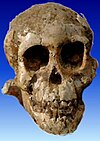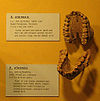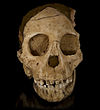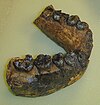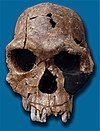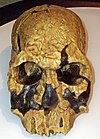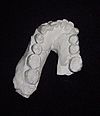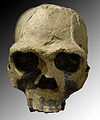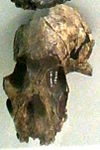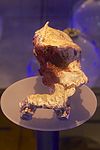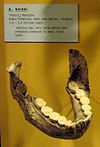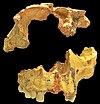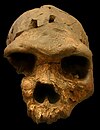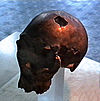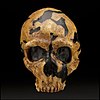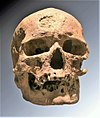« Liste de fossiles d'hominidés » : différence entre les versions
Contenu supprimé Contenu ajouté
→De 5,33 à 2,58 millions d'années : LH4, Little foot, Lucy |
|||
| Ligne 1 179 : | Ligne 1 179 : | ||
| [[Duncan Merrilees]] |
| [[Duncan Merrilees]] |
||
|- |
|- |
||
| [[Fichier:Skull of Gough's Cave.jpg|100px]] |
|||
| [ |
| Crânes de la [[grotte de Gough]]<ref>{{Article | langue = en | prénom1 = Silvia M. | nom1 = Bello | prénom2 = Simon A. | nom2 = Parfitt | prénom3 = Chris B. | nom3 = Stringer | année = 2011 | titre = Earliest Directly-Dated Human Skull-Cups | journal = PLoS One | doi = 10.1371/journal.pone.0017026}}.</ref>{{,}}<ref>{{lien web|langue=en|auteur=Robin McKie, science editor |url=http://www.guardian.co.uk/science/2010/jun/20/ice-age-cannibals-britain-earliest-settlers |titre=Bones from a Cheddar Gorge cave show that cannibalism helped Britain's earliest settlers survive the ice age | Science | The Observer |périodique=Guardian |date=2010-06-20 |consulté le=2012-10-15}}.</ref> |
||
| [[Gough's Cave]] |
|||
| 14,7 ka |
| 14,7 ka |
||
| ''[[Homo sapiens]]'' |
| ''[[Homo sapiens]]'' |
||
| 1927 – |
| 1927 – 1987 |
||
| [[Royaume-Uni]] |
| [[Grotte de Gough]],<br />[[Royaume-Uni]] |
||
| |
| |
||
|- |
|- |
||
Version du 12 novembre 2015 à 20:16
La liste de fossiles d'hominidés présente quelques fossiles d'hominidés en fonction de la datation de leurs restes. Il existe des milliers de fossiles, dont plusieurs sont fragmentaires et ne consistent souvent qu'en de simples os isolés[1], cette liste n'a pas la vocation d'être exhaustive. Elle présente les principaux spécimens retrouvés.
Plusieurs des fossiles ne sont pas liés directement aux ancêtres directs d'Homo sapiens.
Fin du Miocène[2]
De 7 à 5,33 millions d'années
| Nom | Âge | Espèce | Année de découverte |
Lieu | Découvreur | |
|---|---|---|---|---|---|---|

|
TM 266 (Toumai) | 7 Ma[3] | Sahelanthropus tchadensis | 2001 | Tchad | Alain Beauvilain, Fanone Gongdibe, Mahamat Adoum et Ahounta Djimdoumalbaye |
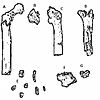
|
BAR 1000'00 | 6 Ma[4] | Orrorin tugenensis | 2000 | Kenya | Martin Pickford, Kiptalam Cheboi, Dominique Gommery, Pierre Mein et Brigitte Senut |
Pliocène[2]
De 5,33 à 2,58 millions d'années
Pléistocène
Paléolithique inférieur : 2,58 millions à 300 000 ans
Paléolithique moyen : 300 000 à 50 000 ans
Paléolithique supérieur : 50 000 à 11 700 ans
Holocène
Mésolithique / Néolithique: 11 700 à 5 000 ans
| Nom | Âge | Espèce | Année de découverte |
Lieu | Découvreur | |
|---|---|---|---|---|---|---|

|
La Brea Woman | ~10 ka | Homo sapiens | 1914 | La Brea Tar Pits, États-Unis |
|

|
Combe Capelle | 9,6 ka[88] | Homo sapiens | 1909 | Combe Capelle, France |
Otto Hauser |
| Cheddar Man | 9 ka | 1903 | Royaume-Uni | |||

|
Kow Swamp 1 | 9 ka - 13 ka | Homo sapiens | 1968 | Australie | A. G. Thorne |
| Afalou 13[89] | 8 ka - 12 ka | Homo sapiens | 1920 | Algérie | Camille Arambourg | |
| Wadi Halfa[90] | 8 ka - 12 ka | Homo sapiens | 1963 | Wadi Halfa, Soudan |
G. Armelagos, E. Ewing, et D. Greene | |
| Wadi Kubbaniya[91] | 8 ka - 20 ka | Homo sapiens | 1982 | Égypte | Fred Wendorf | |

|
Minnesota Woman | 7,8 - 8 ka | Homo sapiens | 1931 | Minnesota, États-Unis |
Albert Jenks grâce à l'équipe du chantier de construction |
| Lo 4b[92] | 6 ka - 9 ka | Homo sapiens | 1965 | Lothagam, Kenya |
H. Robbins et B.M. Lynch | |

|
Femme de Tepexpan | 5 ka - 11 ka | Homo sapiens | 1947 | Tepexpan, Mexique |
Hellmut de Terra |
| SDM 16704[93] | 4,9 ka - 11,8 ka | Homo sapiens | 1929 | États-Unis | M. J. Rogers |
Glossaire
Voici une liste de termes fréquemment utilisés dans les ouvrages listant les fossiles d'hominidés :
- AL - Région d'Afar, en Éthiopie
- ARA-VP - Aramis Vertebrate Paleontology, en Éthiopie
- BAR - (Lukeino, Tugen Hills (en)) district de Baringo (en), Kenya
- BOU-VP - Bouri Vertebrate Paleontology, Éthiopie
- D - Dmanisi, Géorgie
- ER - East Rudolf, Kenya
- KGA - Konso-Gardula, Éthiopie
- KNM - Kenya National Museum
- KP - Kanapoi, Kenya
- LB - Liang Bua, Indonésie
- LH - Laetoli Hominid, Tanzanie
- NG - Ngandong, Indonésie
- OH - Olduvai Hominid, Tanzanie
- SK - Swartkrans, Afrique du Sud
- Sts, Stw - Sterkfontein, Afrique du Sud
- TM - Transvaal Museum, Afrique du Sud
- TM - Toros-Menalla, Tchad
- WT - West Turkana, Kenya
Notes et références
(en) Cet article est partiellement ou en totalité issu de l’article de Wikipédia en anglais intitulé « List of human evolution fossils » (voir la liste des auteurs).
- (en) « Prominent Hominid Fossils »
- http://www.stratigraphy.org/index.php/ics-chart-timescale. ChronostratChart2014-10[1]
- (en) « Fossil Hominids: Toumai », Talkorigins.org,
- (en) « Bar 10200' », Smithsonian National Museum of Natural History (consulté le )
- (en) Bernard Wood, Wiley-Blackwell Encyclopedia of Human Evolution, Wiley-Blackwell, (ISBN 9781118650998, DOI 10.1002/9781444342499)
- (en) Jonathan Amos, « Fossil finds extend human story », BBC News,
- (en) McDougall I. A. N. et Feibel Craig, « Numerical age control for the Miocene-Pliocene succession at Lothagam, a hominoid-bearing sequence in the northern Kenya Rift », Journal of the Geological Society, vol. 156, , p. 731–745 (DOI 10.1144/gsjgs.156.4.0731)
- (en) Andrew Hill et Steven Ward, « Origin of the Hominidae: The Record of African Large Hominoid Evolution Between 14 My and 4 My », Yearbook of Physical Anthropology, vol. 31, no 59, , p. 49–83 (DOI 10.1002/ajpa.1330310505)
- (en) Bryan Patterson, Anna K. Behrensmeyer et William D. Sill, « Geology and Fauna of a New Pliocene Locality in North-western Kenya », Nature, vol. 226, no 5249, , p. 918–921 (PMID 16057594, DOI 10.1038/226918a0, lire en ligne)
- (en)Détails
- (en) Steven Ward et Andrew Hill, « Pliocene hominid partial mandible from Tabarin, Baringo, Kenya », American Journal of Physical Anthropology, vol. 72, no 1, , p. 21–37 (DOI 10.1002/ajpa.1330720104, résumé)
- (en) « Sorry, We Can't Find That Page - Search MSU », sur Msu.edu
- (en) D. C. Johanson, T. D. White et Y. Coppens, « A new species of the genus Australopithecus (Primates: Hominidae) from the Pliocene of eastern Africa », Kirtlandia, vol. 28, , p. 1–14.
- « Oldupai », Ntz.info (consulté le )
- (en) Yohannes Haile-Selassie, Bruce M. Latimer, Mulugeta Alene, Alan L. Deino, Luis Gibert, Stephanie M. Melillo, Beverly Z. Saylor, Gary R. Scott et C. Owen Lovejoy, « An early Australopithecus afarensis postcranium from Woranso-Mille, Ethiopia », PNAS, vol. 107, no 27, , p. 12121–12126 (DOI 10.1073/pnas.1004527107).
- (en) M. Brunet, A. Beauvilain, Y. Coppens, É. Heintz, A.H.E Moutaye et D. Pilbeam, « The first australopithecine 2,500 kilometres west of the Rift Valley (Chad) », Nature, vol. 378, , p. 273-2751 (DOI 10.1038/378273a0).
- (en) « KNM-WT 40000 »
- (en) « Knm-wt-40000 », Smithsonian
- (en) Yohannes Haile-Selassie, Luis Gibert, Stephanie M. Melillo, Timothy M. Ryan, Mulugeta Alene, Alan Deino, Naomi E. Levin, Gary Scott et Beverly Z. Saylor, « New species from Ethiopia further expands Middle Pliocene hominin diversity », Nature, vol. 521, , p. 483-488 (DOI 10.1038/nature14448).
- (en) R. J. Clarke et P. V. Tobias, « Sterkfontein Member 2 foot bones of the oldest South African hominid », Science, vol. 269, no 5223, , p. 521-524 (DOI 10.1126/science.7624772)
- (en) Darryl E. Granger, Ryan J. Gibbon, Kathleen Kuman, Ronald J. Clarke, Laurent Bruxelles et Marc W. Caffee, « New cosmogenic burial ages for Sterkfontein Member 2 Australopithecus and Member 5 Oldowan », Nature, (DOI 10.1038/nature14268).
- (en) Zeresenay Alemseged, Fred Spoor, William H. Kimbel, René Bobe, Denis Geraads, Denné Reed et Jonathan G. Wynn, « A juvenile early hominin skeleton from Dikika, Ethiopia », Nature, vol. 443, , p. 296-301 (DOI 10.1038/nature05047).
- (en) D. C. Johanson et M. Taieb, « Plio-Pleistocene hominid discoveries in Hadar, Ethiopia », Nature, vol. 260, , p. 293-297 (DOI 10.1038/260293a0).
- (en) « Australopithecus afarensis: AL 129-1 », sur http://www.efossils.org/.
- (en) Brian Villmoare, William H. Kimbel, Chalachew Seyoum, Christopher J. Campisano, Erin DiMaggio, John Rowan, David R. Braun, J. Ramon Arrowsmith et Kaye E. Reed, « Early Homo at 2.8 Ma from Ledi-Geraru, Afar, Ethiopia », Science, (DOI 10.1126/science.aaa1343).
- (en) Lee Rogers Berger et al., « Homo naledi, a new species of the genus Homo from the Dinaledi Chamber, South Africa » [« Homo naledi, une nouvelle espèce du genre Homo de la salle Dinaledi, en Afrique du Sud »], eLife 2015;4:e09560, (lire en ligne)Outre Lee Rogers Berger, les co-auteurs de l'article sont John Hawks, Darryl J de Ruiter, Steven E Churchill, Peter Schmid, Lucas K Delezene, Tracy L Kivell, Heather M Garvin, Scott A Williams, Jeremy M DeSilva, Matthew M Skinner, Charles M Musiba, Noel Cameron, Trenton W Holliday, William Harcourt-Smith, Rebecca R Ackermann, Markus Bastir, Barry Bogin, Debra Bolter, Juliet Brophy, Zachary D Cofran, Kimberly A Congdon, Andrew S Deane, Mana Dembo, Michelle Drapeau, Marina C Elliott, Elen M Feuerriegel, Daniel Garcia-Martinez, David J Green, Alia Gurtov, Joel D Irish, Ashley Kruger, Myra F Laird, Damiano Marchi, Marc R Meyer, Shahed Nalla, Enquye W Negash, Caley M Orr, Davorka Radovcic, Lauren Schroeder, Jill E Scott, Zachary Throckmorton, Matthew W Tocheri, Caroline VanSickle, Christopher S Walker, Pianpian Wei et Bernhard Zipfel.
- (en) Lynsey Chutel et Malcolm Ritter, « Study: Bones in South African cave reveal new human relative », sur Phys.org, (consulté le ).
- (en) B. Asfaw, T. D. White, C. O. Lovejoy, B. Latimer, S. Simpson et G. Suwa, « Australopithecus garhi: A New Species of Early Hominid from Ethiopia », Science, vol. 284, no 5414, , p. 629-635 (DOI 10.1126/science.284.5414.629).
- (en) « KNM-WT 17000 », sur http://humanorigins.si.edu (consulté le ).
- (en) William H. Kimbel, Tim D. White et Donald C. Johanson, « Implications of KNM-WT 17000 for the Evoluation of "Robust" Australopithecus », dans Frederick E. Grine, Evolutionary History of the "Robust" Australopithecines, Transaction Publishers, (ISBN 978-0-202-36137-6), p. 259-268.
- (en) Richard J. Sherwood, Steven C. Ward et Andrew Hill, « The taxonomic status of the Chemeron temporal (KNM-BC 1) », Journal of Human Evolution, vol. 42, , p. 153–184 (DOI 10.1006/jhev.2000.0409).
- (en) Lee R. Berger, Darryl J. de Ruiter, Steven E. Churchill, Peter Schmid, Kristian J. Carlson, Paul H. G. M. Dirks et Job M. Kibii, « Australopithecus sediba: A New Species of Homo-Like Australopith from South Africa », Science, vol. 328, , p. 195-204 (DOI 10.1126/science.1184944).
- François Savatier, « Sediba, le « chaînon manquant » entre les Australopithèques et le genre Homo ? », sur http://www.pourlascience.fr, (consulté le ).
- (en) Jonathan Amos, « African fossils put new spin on human origins story », sur BBC News, (consulté le )
- (en) L. L. Mai, M. Y. Owl et M. P. Kersting, The Cambridge Dictionary of Human Biology and Evolution, (présentation en ligne), p. 286
- (en) « OH 8 », sur http://www.modernhumanorigins.net/ (consulté le ).
- (en) L. S. B. Leakey, « A new fossil skull from Olduvai », Nature, vol. 184, , p. 491-493 (DOI 10.1038/184491a0).
- (en) L. S. B. Leakey, « The newest link in Human evolution: the discovery by L. S. B. Leakey of Zinjanthropus boisei », Current Anthropology, vol. 1, no 1, , p. 76-77 (DOI 10.2307/2739676, JSTOR 2739676).
- (en) David Lordkipanidze, Marcia S. Ponce de León et Ann Margvelashvili, « A Complete Skull from Dmanisi, Georgia, and the Evolutionary Biology of Early Homo », Science, vol. 342, no 6156, , p. 326–331 (DOI 10.1126/science.1238484).
- (en) Meave G. Leakey, Fred Spoor, M. Christopher Dean, Craig S. Feibel, Susan C. Antón, Christopher Kiarie et Louise N. Leakey, « New fossils from Koobi Fora in northern Kenya confirm taxonomic diversity in early Homo », Nature, vol. 488, , p. 201–204 (DOI 10.1038/nature11322)
- (en) L. S. B. Leakey, P. V. Tobias et J. R. Napier, « A New Species of the Genus 'Homo from Olduvai Gorge », Nature, vol. 202, no 4927, , p. 7-9 (PMID 14166722, DOI 10.1038/202007a0, lire en ligne).
- (en) L. Pu, C. Fang, M. Hsing-Hua, P. Ching-Yu, H. Li-Sheng et C. Shih-Chiang, « Preliminary study on the age of Yuanmou man by palaeomagnetic technique », Scientia Sinica, vol. 20, no 5, , p. 645–664 (PMID 339347)
- Rukang Wu et Lanpo Jia, « La Chine durant la période de l'Homo habilis et de l'Homo erectus », dans Corinne Julien, Histoire de l'humanité, Volume 1, UNESCO, (ISBN 978-92-3-202810-5), p. 237.
- (en) « KNM-ER 406 », sur Smithsonian National Museum of Natural History (consulté le ).
- (en) Donald C. Johanson et Blake Edgar, From Lucy to Language, New York, Simon & Schuster, , p. 158
- (en) « KNM-ER 23000 », sur Smithsonian Museum of Natural History (consulté le ).
- Richard Leakey et Alan Walker, « New Australopithecus boisei specimens from east and west Lake Turkana, Kenya », American Journal of Physical Anthropology, vol. 76, no 1, , p. 1-24 (DOI 10.1002/ajpa.1330760102).
- (en) Alan Walker et Richard Leakey, The Nariokotome Homo erectus Skeleton, Harvard University Press, , 457 p. (ISBN 3-540-56301-6, résumé).
- (en) Franck Brown, John Harris, Richard Leakey et Alan Walker, « Early Homo erectus skeleton from west Lake Turkana, Kenya », Nature, vol. 316, , p. 788-792 (DOI 10.1038/316788a0).
- (en) « SK 46 », sur Smithsonian National Museum of Natural History (consulté le ).
- (en) Michael Hopkin, « Fossil find is oldest European yet », Nature News, (DOI 10.1038/news.2008.691)
- (en) J. M. Bermúdez de Castro, J. L. Arsuaga, E. Carbonell, A. Rosas, I. Martínez et M. Mosquera, « A Hominid from the Lower Pleistocene of Atapuerca, Spain: Possible Ancestor to Neandertals and Modern Humans », Science, vol. 276, no 5317, , p. 1392-1395 (DOI 10.1126/science.276.5317.1392).
- (en) « Trinil 2 », sur Smithsonian National Museum of Natural History (consulté le ).
- Camille Arambourg, « Le gisement de Ternifine et l'Atlanthropus », Bulletin de la Société préhistorique de France, vol. 52, nos 1-2, , p. 94-95.
- (en) Angela M. H. Schuster, « New Skull from Eritrea », Archaeology, vol. 51, no 5, (lire en ligne)
- (en) « Bodo », sur http://www.modernhumanorigins.net (consulté le ).
- (en) Ronald Singer, « The Saldanha skull from Hopefield, South Africa », American Journal of Physical Anthropology, vol. 12, no 3, , p. 345–362 (PMID 13207329, DOI 10.1002/ajpa.1330120309).
- (en) Peter Brown, « Chinese Middle Pleistocene hominids and modern human origins in east Asia », dans Lawrence Barham et Kate Robson Brown, Human Roots. Africa and Asia in the Middle Pleistocene, Bristol, Western Academic & Specialist Publishers, (ISBN 978-0953541843), p. 139–140.
- Gaspard Guipert, Marie-Antoinette de Lumley et Henry de Lumley, « Restauration virtuelle d’Arago 21 », Comptes Rendus Palevol, no 1, , p. 51–59 (DOI 10.1016/j.crpv.2013.07.004).
- Voir aussi liste des restes humains découverts dans la caune de l'Arago.
- (en) P. Brown, Dali archaic Homo Sapiens, University of New England, Australie (lire en ligne)
- (en) Chun-Hsiang Chang, Yousuke Kaifu, Masanaru Takai, Reiko T. Kono, Rainer Grün, Shuji Matsu’ura, Les Kinsley et Liang-Kong Lin, « The first archaic Homo from Taiwan », Nature Communications, vol. 6, no 6037, (DOI 10.1038/ncomms7037).
- « Le crâne de la grotte de Lamalunga appartenait bien à un homme de Néandertal », sur http://www.hominides.com/, .
- (en) Martina Lari et al., « The Neanderthal in the karst: First dating, morphometric, and paleogenetic data on the fossil skeleton from Altamura (Italy) », Journal of Human Evolution, vol. 82, , p. 88-94 (DOI 10.1016/j.jhevol.2015.02.007).
- (en) Tim D. White, B. Asfaw, D. DeGusta, H. Gilbert, G. D. Richards, G. Suwa et F. C. Howell, « Pleistocene Homo sapiens from Middle Awash, Ethiopia », Nature, vol. 423, no 6491, , p. 742–747 (PMID 12802332, DOI 10.1038/nature01669, Bibcode 2003Natur.423..742W).
- (en) « Jebel Irhoud », sur Max Planck Institute.
- (en) T. M. Smith, P. Tafforeau, D. J. Reid, J. Pouech, V. Lazzari, J. P. Zermeno, D. Guatelli-Steinberg, A. J. Olejniczak, A. Hoffman, J. Radovcic, M. Makaremi, M. Toussaint, C. Stringer et J.-J. Hublin, « Dental evidence for ontogenetic differences between modern humans and Neanderthals », Proceedings of the National Academy of Sciences, vol. 107, no 49, , p. 20923–20928 (DOI 10.1073/pnas.1010906107)
- Bernard Vandermeersch, « Qafzeh, histoire des découvertes », Bulletin du Centre de recherche français à Jésuralem, vol. 18, , p. 8-19 (lire en ligne).
- (en)Qafzeh IX
- (en) Christopher J. Norton et David R. Braun, Asian paleoanthropology: From Africa to China and beyond, New York, Springer, , 216 p. (ISBN 978-9048190935, DOI 10.1007/978-90-481-9094-2, présentation en ligne), p. 107
- (en) « What does it mean to be human? », Smithsonian National Museum of Natural History (consulté le )
- Jean-Lucien Couchard, Anne Dambricourt-Malassé, Pierre-Yves Demars, Marie-Françoise Diot, Jean-Luc Guadelli, Jean-Louis Heim, Jean-Jacques Hublin, Yves Pautrat et Jean-Paul Raynal (préf. Yves Coppens), L'homme de la Chapelle-aux-Saints, Limoges, Culture & Patrimoine en Limousin, , 81 p. (ISBN 2-911167-17-1).
- Léon Henri-Martin, « Recherches sur l'évolution du Moustérien dans le gisement de la Quina (Charente) - t. 3 : l'homme fossile de La Quina », Mémoires de la Société Archéologique et Historique de la Charente, vol. 14, , p. 260.
- Marylène Patou-Mathis, Neanderthal. Une autre humanité, Perrin, (ISBN 978-2262022723).
- Léon Henri-Martin, « Recherches sur l'évolution du Moustérien dans le gisement de la Quina (Charente) - t. 4 : l'enfant fossile de La Quina », Mémoires de la Société Archéologique et Historique de la Charente, vol. 14, , p. 158
- (en) Jeffrey H. Schwartz et Ian Tattersall, The Human Fossil Record. Volume 2. Craniodental Morphology of Genus Homo (Africa and Asia), (ISBN 0-471-31928-7), p. 311-313.
- (en) Tom Higham, Tim Compton, Chris Stringer, Roger Jacobi, Beth Shapiro, Erik Trinkaus, Barry Chandler, Flora Gröning, Chris Collins, Simon Hillson, Paul O’Higgins, Charles FitzGerald et Michael Fagan, « The Earliest Evidence for Anatomically Modern Humans In Northwestern Europe », Nature, vol. 479, no 7374, , p. 521-524 (DOI 10.1038/nature10484).
- (en) Ann Gibbons, « Who Were the Denisovans? », Science, vol. 333, no 6046, , p. 1084–1087 (PMID 21868646, DOI 10.1126/science.333.6046.1084).
- (en) Johannes Krause, Qiaomei Fu, Jeffrey M. Good, Bence Viola, Michael V. Shunkov, Anatoli P. Derevianko et Svante Pääbo, « The complete mitochondrial DNA genome of an unknown hominin from Southern Siberia », Nature, vol. 464, , p. 894-897 (DOI 10.1038/nature08976).
- (en) Michael Balter, « Researchers Discover New Lineage of Ancient Human », sur Science, .
- (en)Timeline at Bone & Stone
- (en) Leonard Freedman et Mancel Lofgren, « Human skeletal remains from Lake Tandou, New South Wales », Archaeology in Oceania, vol. 18, no 2, , p. 98-105 (JSTOR 40386634).
- (en) Silvia M. Bello, Simon A. Parfitt et Chris B. Stringer, « Earliest Directly-Dated Human Skull-Cups », PLoS One, (DOI 10.1371/journal.pone.0017026).
- (en) Robin McKie, science editor, « Bones from a Cheddar Gorge cave show that cannibalism helped Britain's earliest settlers survive the ice age | Science | The Observer », Guardian, (consulté le ).
- (en) « Mystery of a West African skull from 13,000 years ago », Natural History Museum, London, UK (consulté le )
- (en) « Travels and Archeology in South Chile », Cornell University, New York, U.S. (consulté le )
- (en) Paul Storm et Andrew Nelson, « The many faces of Wadjak man », Archaeology Oceania, vol. 27, no 1, , p. 37–46 (lire en ligne)
- (de) Christoph Seidler, « Forscher entzaubern Steinzeitmann », Der Spiegel, (lire en ligne, consulté le )
- (en) « Afalou-bou-Rhummel », sur Catalogue of Fossil Hominids Database (consulté le ).
- (en) David L. Greene, George H. Ewing et George J. Armelagos, « Dentition of a Mesolithic Population from Wadi Halfa, Sudan », American Journal of Physical Anthropology, vol. 27, no 1, , p. 41-56.
- (en) Fred Wendorf et Romuald Schild, « The Wadi Kubbaniya skeleton: a Late Paleolithic burial from southern Egypt », dans The Prehistory of Wadi Kubbaniya. Volume 1, Southern Methodist University Press, (ISBN 9780870742163).
- (en) Joseph F. Powell, The First Americans: Race, Evolution and the Origin of Native Americans, Cambridge University Press, (ISBN 9780521530354), p. 169–170.
- (en) Joseph F. Powell, The First Americans: Race, Evolution and the Origin of Native Americans, Cambridge University Press, (ISBN 0-521-82350-1), p. 146-147.
Bibliographie
- Tattersall, Ian, Schwartz, Jeffery, Extinct Humans, Westview Press, Boulder CO, (ISBN 978-0-8133-3482-0).
- Larsen, Clark Spencer, Matter, Robert M, Gebo, Daniel L, Human Origins: the fossil record, Waveland Press, Prospect Heights, IL, (ISBN 978-0-88133-575-0).
- « Smithsonian Human Origins Program » (consulté le )
- « Prominent Hominid Fossils » (consulté le )
- F.E. Grine, W.L. Jungers et J. Schultz, « Phenetic Affinities Among Early Homo Crania from East and South Africa », Journal of Human Evolution, vol. 30, no 3, , p. 189–225 (DOI 10.1006/jhev.1996.0019)
- (en) Bernard Wood, Wiley-Blackwell Encyclopedia of Human Evolution, Wiley-Blackwell, (ISBN 9781118650998, DOI 10.1002/9781444342499).
Voir aussi
Articles connexes
Liens externes
- Carte du monde interactive de fossiles de primates sur www.edutube.org










